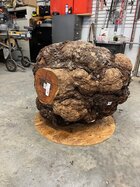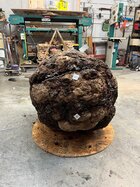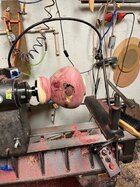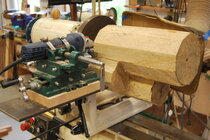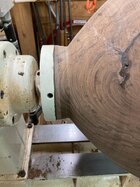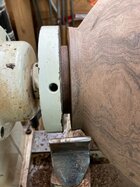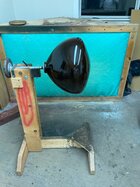Almost 25-years ago I got mesmerized on Moulthrop's work and redirected without looking back. If you check out Ed's, Philip's, and Chris' work, you'll note that all are "big" - they have "presence". I think all will agree that a 5" diameter and a 20-" diameter, with the same design, out of the same log, and with the same finish, are very different: one is cute and the other commands attention. The problem is, big turnings come from big (and heavy) logs, take a big lathe and can hurt real bad if you screw-up.
- All logs start between centers with 1.5" four-prong spur and live-center. After determining the axis, I drill a shallow 1.5" hole, with a forstner, about 1/4' deep for the drive, and a shallow 9/16" forstner hole for the live-center, assuming Oneway live-center. Keep both shallow - you may have to adjust the axis
- Raise up with your chain-hoist - a one-ton from Harbor Frt costs around $60 - a barn-door track and car from Grainger are about $40 - I ran out of neighbors willing to help mount a 200-lb+++ log a long time ago. Adjusting the axis becomes no big deal and reversing on the lathe is easy
- Snug it up and go. The live-center end will be the tenon for faceplate
- Turn the outside to final design - no returning to fix it later
- Cut the tenon same dia as your faceplate - my faceplates are 6" Oneway. Make the tenon surface "aero-space flat" or a teeny bit concave. Next step is to precision drill: I use #14 SS oval-head sheet metal, 1.25" for inside holes, 1" for outside holes (tips ground off). I found marking with "hinge-drills" to be invaluable when drilling 18-holes. Then drill holes with 11/64" bit with a depth stop set to the screw extension. The #14 screws and hole count assume the 6" Oneway faceplate
- Mount on the head-stock and secure with live-center for final rounding/balancing. Then remove tail-stock and start hollowing. You shouldn't need a steady-rest - with screws properly hand-torqued, it ain't going anywhere.
- After hollowing to maybe 1" thick (to allow for warpage) you're ready to dry. Boiling in a large pot for about 2-hours minimizes cracking and speeds final drying - allow 8-mos to a year for drying

